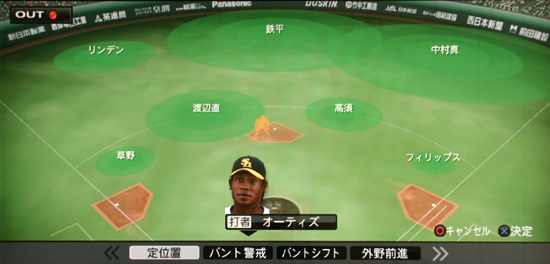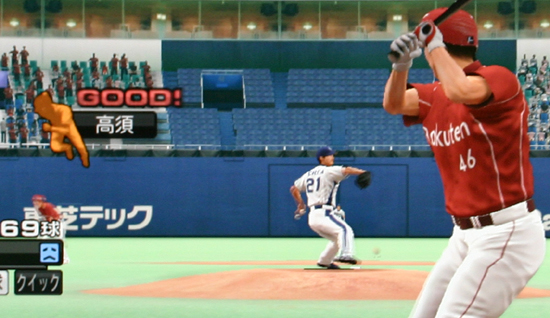IN-GAME SCREEN TRANSLATIONS
 |
Middle: Akamatsu just swung & missed on this pitch. The little ball cursor shows the ending location of the pitch; so he swung under the ball completely missing and ended up off balance. The goal is to his the ball inside the sweet spot (white circle inside the bat.) The size of the sweet spot changes every pitch depending on attributes and special skills. To the left of the bat you'll see he has a cold spot, so the sweet spot would be reduced significantly if he tried to hit a low, inside pitch. Below the bat it shows the last pitch thrown (Drop Curve) and speed (111 kmh.) This info will only appear of course after a pitch. Bottom left: The 3 bars reflect the hitter's ability in real time. From top to bottom, the abilities are: Power, Contact, and Speed. You may have noticed that the Contact bar has 2 colors (grey + blue). That's because this particular hitter has the "strikeout" ability which lowers his contact skills when he has 2 strikes. Normally, he is a good contact hitter (grey + blue length). But once he is down to 2 strikes, he loses the blue portion and is only left with the grey portion, leaving him with a very small hitting cursor and poor contact skill. Bottom right: This is the hitter's name plate which features the following info: His place in the batting order (1, as in leadoff hitter), his position (pinch hitter in this pic), his name, his condition (Normal), and then his special skills. For some hitters, you can see a tiny white dot next to his happy face. A white dot means he is a left-handed hitter, while 2 white dots mean that he is a switch-hitter. You might also see stats which display Avg/Homeruns/RBI's. |
 |
This image is from the pitching screen. At top left is the pitch speed guage which shows you what the CPU batter is expecting (as represented by red bars.) The more to the left the gauge is, the slower the pitch he is expecting. The more to the right, the faster. The blue circle represents the speed of your selected pitch, so basically you want to keep this away from large, bright red bars when possible. This can be turned off in settings. Pitcher Stamina Bar: Inside the pitchers name plate you'll see a fatigue bar which changes colors during the game. You should remove a pitcher when the bar is nearly empty (it will turn red at that point). Also if your pitcher is rattled, the bar will start to blink in red, so you'll need to get a few outs in order to settle down again. At the bottom below each of the name plates are the (abbreviated) players special skills. If the box is white, it is a positive skill. If the box is black, it is a negative skill. And finally if you look carefully at the box to the left of the black box a bit closer you will see that there is actually a grey line under it. That means it is a Neutral skill. If you want to to understand what these mean simply refer to the "Special Skills" section on this site. For example the pitchers skill on the far bottom left means he stays calm with runners in scoring position. This was found in the pitching page in the Special Skills section. The batters bad skill on right (in black) means he is poor at bunting. |
 |
 |
| When an exclamation appears above a pitcher's head, it means they messed up their release point and thrown a very bad pitch or "meatball." To the right of the exclamation is the ball, the large "meatball" in the center is the Batting Point. | Here is batting with the 'Pitch Point' set to ON which can be used as an aim assist (the blue circle will contract during the pitchers wind-up.) You can turn this option or the Batting Point off or modify them in settings. |
 |
|
| Defensive Shift screen viewable by clicking L1. The 4 shift options shown at bottom are Normal Shift, Bunt Warning, Bunt Shift, and Outfield In. The dark green circles represent the fielder's range. See the Defensive Shifts page for a full translation of all the shifts. | |
 |
| On the left side of this screen you'll see an icon which says "GOOD!", this means a runner is stealing base. You can actually see the runner in motion attempting to steal 3rd base right under the icon. In this situation you can hold square button while the pitch is coming in to have the catcher throw it to 3rd base. Every now and then you will see an indicator like a base runner is taking off, but it will blink. You're supposed to check the runner in these situations, so have your catcher throw to first to try and pick off the runner. |
 |
 |
| Similar to some TV broadcasts, most starters in the game are given a short 2-3 sentence introduction when they first come to bat during exhibition. This player is Inaba Atsunori for the Fighters. His intro says "A complete professional and team player who excels in all areas - Hitting, Defense, and Baserunning. His clutch hitting is invaluable in holding the lineup together." | Occasionally some statistics will be shown when a batter comes up, such as their performance today (as in this picture - the batter is 2 for 4 today; the pink boxes are hits, the white boxes are outs) or maybe it will show their average with runners in scoring position. If you are in season mode you will also see updates like the top 10 batting leaders or homerun leaders. |
 |
| Towards the late innings, if your starter is still in the game, you will also see a game summary of his performance so far. At the bottom, it shows that this pitcher has faced 20 batters, given up 5 hits, 0 homeruns, 1 walk/hit-by-pitch, struck out 4, and allowed 1 run. In the colorful bar graph you can see his current pitch distribution. Today he has thrown 71 pitches with this breakdown: 77% fastballs, 8% curves, 7% sliders, 4% high speed sliders, and 4% others. |
PLAYER CONDITION:
Condition faces directly affect your hitting and pitching ratings but does not affect your speed or defense. For example in PYS 2010 the very happy face increases contact 5% and power 12%, while the very sad face decreases them 5% and 12%. For detailed bonus info for each respective face please see the condition page in the 'Attributes' section.
|
How you use this information depends on... 1) How valuable your player is on defense since he would still help your team even if he's in a hitting slump. 2) how good his base ability is because I'm sure you would still rather have an A hitter with a very sad face over a 'F' hitter with a very happy face. Also there are there are some rare conditions that you will only see in 'Pennant Mode' since they deal with injuries: Very angry red face: Small injury. Can still play but abilities will drop and high risk of further injuries. Grey face: Serious injury. This one is rare and perhaps you get this if your "small injury" players are used until they get hurt even more (but that's a guess.) Green face: deactivated/DL face. |


